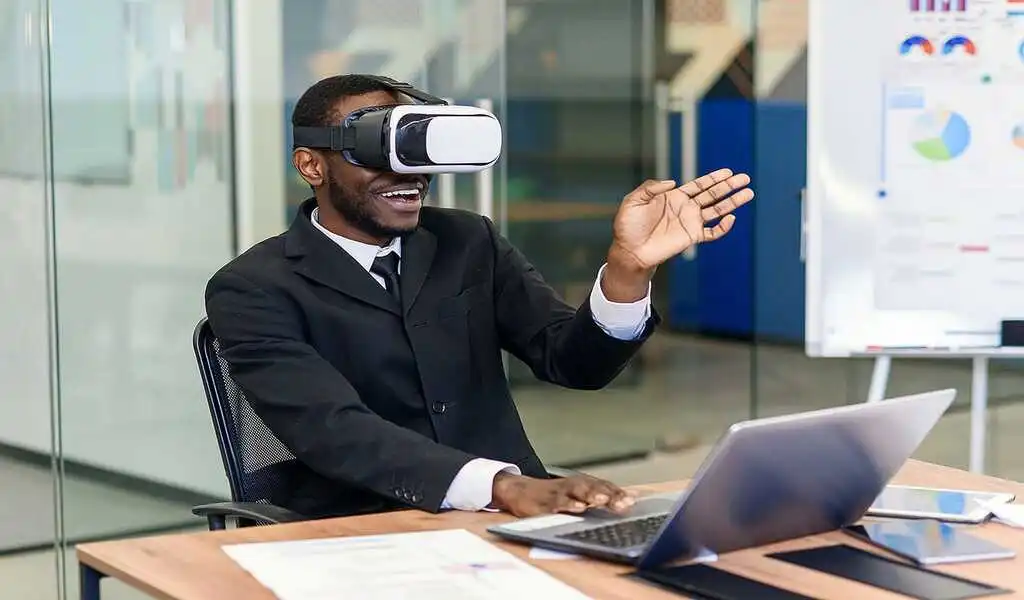In recent years, the landscape of remote work has undergone a transformative shift, largely propelled by advancements in virtual reality (VR) technology. This revolutionary tech is not just a tool for entertainment; it’s becoming pivotal in enhancing productivity in remote work environments.
Integrating VR into remote work settings redefines traditional work paradigms, offering new methods for collaboration, communication, and engagement.
The Emergence of VR in Remote Work
Virtual reality’s journey from a gaming novelty to a serious tool in the remote work arsenal is remarkable. Once perceived as futuristic and inaccessible, this technology is now at the forefront of remote work solutions.
VR offers an immersive experience that transcends geographical boundaries, enabling a more connected and interactive work environment.
Companies increasingly adopt VR to facilitate a virtual workspace replicating the physical office experience. This adoption signifies a major shift in how businesses perceive remote work, moving from a necessity in crisis to a strategic, long-term solution.
Enhancing Collaboration and Communication
One of the most significant impacts of VR technology in remote work is enhancing collaboration and communication. Virtual meeting rooms and collaborative spaces in VR allow teams to interact as if they were in the same physical space.
This technology enables more natural and engaging meetings, overcoming the limitations of traditional video conferencing. Through VR, team members can share 3D models, conduct virtual walkthroughs, and engage in real-time brainstorming sessions, fostering deeper collaboration and understanding.
Expanding Training and Development Opportunities
Ella Rose, the CEO of Pcbinsider, talks about the training opportunities,
Virtual reality is revolutionizing training and professional development in remote work settings. With VR, employees can engage in realistic simulations and training programs regardless of location.
This is particularly beneficial in fields where hands-on experience is crucial, such as healthcare, engineering, and manufacturing.
VR enables employees to practice skills, understand complex processes, and receive immediate feedback in a risk-free environment. This accelerates the learning curve and enhances the quality of training, leading to better-prepared and more competent professionals.
Fostering Creativity and Innovation
Scott Trachtenberg, CEO of ADA Compliance, stresses the importance of VR technology,
VR technology is pivotal in fostering creativity and innovation in remote work environments. VR’s immersive and interactive nature encourages employees to think outside the box and explore new ideas in a virtual space.
It allows for creating virtual prototypes, design models, and experimental scenarios without the constraints and costs of physical resources.
This freedom to experiment and visualize ideas in 3D ignites creative thinking and paves the way for innovative solutions. As a result, teams can push the boundaries of creativity, leading to breakthroughs that might not have been possible in a traditional work setting.
Boosting Productivity and Engagement
John Webster, the owner of Pcbitalian, speaks about the employee’s productivity,
VR technology is not just improving how teams communicate but also boosting overall productivity and employee engagement. VR’s immersive nature helps minimize distractions, a common challenge in traditional remote work settings.
By providing a controlled and customizable environment, VR allows individuals to focus better, increasing productivity. Moreover, VR’s interactive and engaging experiences help reduce the isolation often felt in remote work, thus enhancing employee morale and motivation.
Challenges and Future Directions
Despite its numerous benefits, VR in remote work also faces challenges. The cost of VR equipment and the need for high-speed internet are barriers to widespread adoption. Additionally, there are concerns regarding prolonged VR usage’s physical and psychological effects.
However, as technology evolves, these challenges are gradually being addressed. The future of VR in remote work looks promising, with potential advancements like more ergonomic and affordable VR devices and improved virtual collaboration tools.
Virtual reality technology is undeniably reshaping the landscape of remote work, offering innovative solutions to enhance productivity and collaboration. As VR becomes more accessible and integrated into our work lives, it can revolutionize how we work remotely and how we perceive and experience work.
Embracing this technology can lead to more dynamic, engaging, and productive work environments, paving the way for a new era in the remote working world.
SEE ALSO: Google Plans To Remove ‘Inactive’ Accounts Starting December: What You Need To Know
⚠ Article Disclaimer
The above article is sponsored content any opinions expressed in this article are those of the author and not necessarily reflect the views of CTN News






